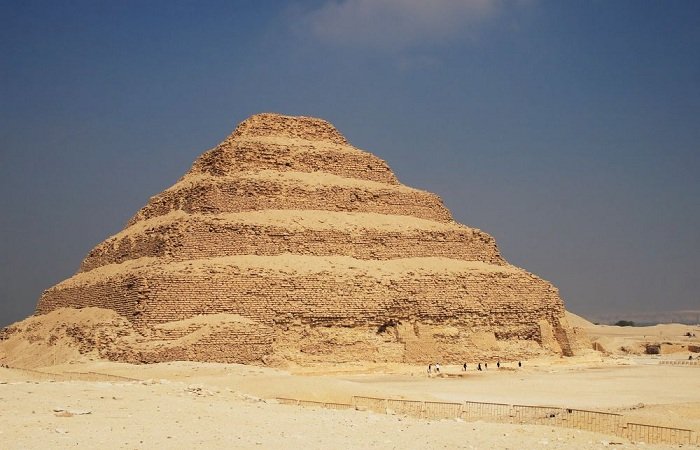Wonderful Saqqara necropolis.
Saqqara necropolis
Location
The cemetery of Saqqara located west of ancient Memphis is one of the most important archaeological sites in Egypt. Over six kilometers long, it boasts thousands of underground burial sites, as well as the six-step Djoser pyramid – Egypt’s oldest pyramid.
The ruins at Saqqara have long attracted the interest of explorers. Travelers first reported evidence of antiquities at Saqqara in the 16th century. The Djoser Pyramid and the smaller pyramids around it were hard to miss – but the size of the necropolis only became apparent with the advent of excavations in the 19th century.
Saqqara necropolis
Saqqara is one section of the great necropolis of Memphis, the Old Kingdom capital, and the kings of the 1st Dynasty, as well as that of the 2nd Dynasty, are mostly buried in this section of the Memphis necropolis. It has been of constant interest to Egyptologists. Saqqara is best known for the Step Pyramid, the oldest known of Egypt’s 97 pyramids. It was built for King Djoser of the 3rd Dynasty by the architect and genius Imhotep, who designed it and its surrounding complex to be as grand as it was unique and revolutionary sometimes referred to as the Step Tomb due to its rectangular base, as well as a number of mastabas (Arabic word meaning ‘bench’). Located some 30 km south of modern-day Cairo, Saqqara covers an area of around 7 by 1.5 km (4.3 by 0.93 mi). Imhotep was the first to build stone tombs in honor of the king’s majesty. His many titles included ‘Treasurer of the King of Lower Egypt’, ‘Administrator of the Great Palace’, and ‘Imhotep the Builder, the Sculptor, the Maker of Stone Vessels’. Imhotep may have also designed the pyramid of Djoser’s successor, Sekhemkhet.
Also known as the “Step Pyramid,” Djoser’s Pyramid stands in the Saqqara Necropolis.
The pyramid consists of six mastabas and inside the pyramid there are galleries and wells dug directly into the rock, in which a deposit of mummies of the royal family was found.
The white and turquoise ceramics that were found inside the pyramid and the very heavy pink granite slabs that covered the burial chamber are very famous.
Also in Saqqara is the tomb of Mehu, recently opened to the public for the first time since its discovery in 1940. This dignitary of the sixth dynasty was buried with the highest honors in a place which, thanks to its secluded position, managed to survive the raids of looters and to keep its hieroglyphs in good condition.
Saqqara necropolis Highlights
At Saqqara, the oldest complete stone building complex known in history was built: Djoser’s step pyramid, built during the third dynasty. Another 16 Egyptian kings built pyramids at Saqqara, which are now in various states of preservation or dilapidation. High officials added private funeral monuments to this necropolis during the entire pharaonic period. It remained an important complex for non-royal burials and cult ceremonies for more than 3,000 years, well into Ptolemaic and Roman times. You can explore lots of artifacts from Saqqara in the national and international museums around the world.
The most highlights of Saqqara are the pyramids of Djoser, Unas pyramid, Teti pyramid. And the daily life inscriptions in the outstanding old kingdom high official tombs such as Mereruka, Kagemni, Ptah-Hotep family, and Mehu. The new kingdom tombs such as Horemhep, Maya, Tia, and Merynieth. And the unique Serapeum of the sacred bull Apis.
Saqqara necropolis new discovery
A lot of new discoveries happens at Saqqara necropolis :
The embalming workshop, The oldest cheese known to man in a cemetery, The rock-cut tomb-chapel of Wahty and a hug cat mummy
The most recent discovery at Saqqara is a hug cat, perhaps a lion or a lioness. The ancient Egyptians are known to have a great interest in cats, often imposing sanctions on those who harmed cats or killed them. ancient Egyptians worshipped a half-cat-half-woman goddess named “Bastet”.
Wahty was the royal purification priest, royal supervisor, and inspector of the sacred boat of king Neferirkare the fifth dynasty. The reliefs depict Wahtye himself, his wife, Weret Ptah, and his mother, Merit Meen, as well as everyday scenes that include hunting, sailing, making offerings, and manufacturing goods such as pottery and funerary furniture. Large painted statues of the priest and his family fill 18 niches, while 26 smaller niches near the floor hold statues of an as yet unidentified person either standing or seated with legs crossed, as a scribe.
Another colorful tomb has been discovered, the tomb belonged to a senior official named Khuwy who is believed to have been a nobleman during the Fifth Dynasty, a period spanning the 25th to the 24th century BC, The findings raise questions about Khuwy’s influence and his relationship to Pharaoh Djedkare Isesi, who ruled ancient Egypt during the Fifth Dynasty. Isesi’s pyramid is not far from where the tomb was found, leading some to suggest Khuwy might have been related to Pharaoh Isesi.
Both Saqqara and Abusir have approximately 30 royal complexes and over 350 non-royal tombs or parts of tombs dates back to old kingdom. And the famous tombs of the new kingdom.
The pharaohs did the impossible. Explore their mysterious ancient pyramid and tombs … with Explore Egypt Tours Team.
Explore Egypt Tours Tripadvisor




Comment (0)